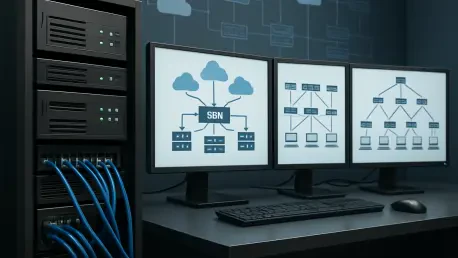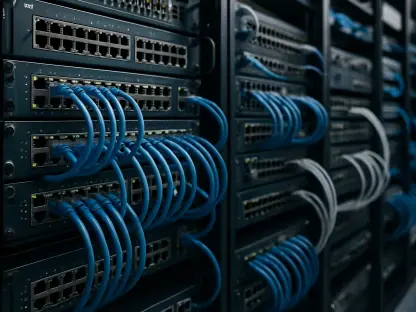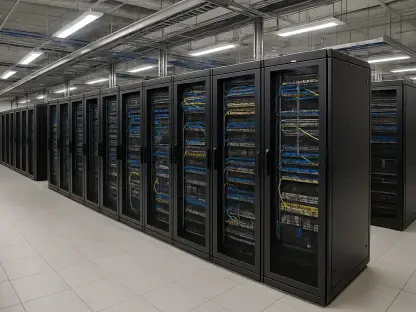The financial sector is undergoing a significant transformation driven by the integration of artificial intelligence (AI) with software-defined networking (SDN). These two cutting-edge technologies are fundamentally reshaping the way financial services institutions (FSIs), fintech companies, and decentralized finance (DeFi) platforms operate by creating a more secure, adaptable, and efficient infrastructure. A notable disparity exists between the traditional, hardware-focused networks and the current market’s need for quick adaptation to both technological advancements and consumer demands. With these evolving needs, institutions are facing mounting pressure to innovate and stay ahead. This digital upheaval marks an era where modern financial networks must transition from static and rigid systems to fluid and smart infrastructures to maintain competitive advantages and secure customer trust.
Modernization Imperative in Finance Networks
For decades, financial services have relied on centralized, hardware-driven networks that, although considered robust, struggle with the flexibility needed to adapt swiftly to market dynamics and emerging cybersecurity threats. The limitations of these legacy systems are becoming increasingly apparent as digital transformation accelerates. In an industry where milliseconds can translate into substantial financial fortunes, there is an urgent need for more dynamic and responsive network infrastructures. The introduction of AI and SDN offers a much-required leap forward, providing the agility essential for modern-day financial operations. Software-defined networking decouples the control plane from the data plane, enabling centralized, programmable control over the network. When enriched with AI capabilities, these systems can evolve into self-optimizing, intelligent networks that make real-time decisions without human intervention.
As financial entities seek to modernize, their aim is not only to leverage AI and SDN for enhanced operational efficiency but also to address security concerns and remain compliant with regulatory demands. The synergy between AI and SDN has introduced new paradigms where networks anticipate requirements and preemptively adjust configurations, thus creating environments that are both resilient and context-driven. This evolution is not merely a technological upgrade; it represents a complete shift in how financial infrastructures are conceptualized and implemented. Institutions embracing these changes find themselves at the forefront of industry innovation, paving the way for the next generation of financial services that prioritize agility and responsiveness.
AI-Enabled Network Efficiency
AI-driven innovations are already proving transformative in optimizing network efficiency, particularly in reducing latency and enhancing performance. This is paramount in high-frequency trading environments, where even the sliver of a millisecond can have immense financial consequences. By leveraging AI’s predictive capabilities, networks can foresee congestion and intelligently reroute traffic, ensuring seamless operation and reducing delays. The capability for AI-driven SDN to manage data flows autonomously represents a breakthrough in network management. These systems analyze vast quantities of real-time data, learning and adapting to evolving patterns, thus enhancing overall network efficiency.
Such improvements facilitate more than just speed; they bring about a fundamental change in the assurance of service quality. Financial institutions benefit by being able to offer consistently reliable services, which are indispensable in maintaining client satisfaction and trust. Additionally, the predictive nature of AI allows for preemptive maintenance, where potential issues are addressed before they escalate into significant problems. By minimizing downtimes and optimizing resource allocation, AI-driven SDN not only heightens efficiency but contributes to a more sustainable operational model. As financial networks become increasingly intertwined with digital processes, these innovations will define the cornerstone of next-generation financial service delivery, reinforcing both performance and reliability in unprecedented ways.
Strengthening Cybersecurity with AI and SDN
The integration of AI into SDN presents a significant leap forward in the realm of cybersecurity, offering a proactive defense mechanism. Traditionally, the financial industry’s approach to cybersecurity has been reactive, addressing vulnerabilities only after a breach occurs. However, AI-driven SDN systems can autonomously monitor network traffic and detect anomalies, allowing them to predict and forestall potential threats. Pattern recognition capabilities in AI enhance the understanding of network behavior, providing detailed insights that aid in early threat detection. This approach fundamentally alters the cybersecurity landscape, shifting from reactive measures to anticipatory strategies. Networks become capable of isolating threats swiftly, reducing the window of opportunity for malicious actors.
Furthermore, automated responses facilitated by AI eliminate reliance on manual interventions, which are often slower and prone to error. These autonomous systems ensure that financial institutions effectively implement a zero-trust architecture, continuously scrutinizing network activity and securing data boundaries. By enhancing network security through AI and SDN, financial entities not only protect sensitive client information but also safeguard their reputation, fostering trust and confidence among stakeholders. Embracing AI-driven cybersecurity measures, financial networks advance toward a fortified future characterized by resilience against ever-evolving digital threats.
Navigating Compliance and Automation Challenges
Regulatory compliance remains a formidable challenge in the financial sector, with global regulations constantly evolving and requiring meticulous adherence. However, the convergence of AI and SDN provides opportunities to streamline these processes. AI-powered SDN can dynamically adjust to regulatory changes and automatically enforce compliance measures, substantially reducing the risk of human error. By automating compliance tasks, institutions can focus resources on strategic initiatives instead of getting bogged down by manual oversight. The ability of AI to continuously evaluate regulatory landscapes ensures that networks remain compliant without requiring constant human monitoring.
Additionally, this technological synergy assists in cost reduction associated with compliance management. Automation significantly lowers the manpower needed and speeds up the compliance process, making it not only more cost-effective but also more reliable. The reduction of human intervention minimizes potential errors and assures consistent adherence to regulations. This adaptability is crucial for financial institutions operating in multiple jurisdictions with varying regulatory requirements. AI and SDN together enable seamless, instant compliance, placing financial organizations in an advantageous position to respond to any regulatory shifts promptly. This alignment with regulatory demands not only mitigates risks but also fosters a culture of trustworthiness and accountability in financial operations.
Sustainability Efforts through AI and SDN
An increasing focus on sustainability and reducing carbon footprints is prompting financial institutions to seek innovative solutions. The integration of AI and SDN presents a pathway to significantly enhance energy efficiency within data centers, a key area of focus for reducing environmental impact. AI optimizes traffic routing and resource allocation, minimizing unnecessary power consumption and promoting a more eco-friendly operational framework. By utilizing intelligent algorithms, AI-driven SDN can dynamically adjust to workload demands, ensuring that energy-intensive operations are performed only when necessary.
This approach aligns financial operations with global climate initiatives, exemplifying a commitment to sustainable business practices. As financial institutions modernize their infrastructure, sustainability becomes a natural byproduct of efficiency improvements brought by AI and SDN. These advancements offer long-term benefits, enabling companies not only to cut costs associated with energy consumption but also to enhance their corporate image. Customers and investors are increasingly valuing sustainability as a core business attribute, influencing their partnerships and engagements. Embracing AI and SDN technologies enables financial entities to demonstrate leadership in environmental responsibility, fostering a competitive advantage in the marketplace and aligning with the values of a growing environmentally-conscious clientele.
Conclusion: Embracing AI and SDN for a Resilient Future
For years, financial services have depended on centralized, hardware-heavy networks. While these networks are tough, they often lack the flexibility to keep up with market changes and new cybersecurity threats. As digital transformation speeds up, the shortcomings of these older systems are becoming more obvious. In finance, where seconds can mean huge profits or losses, there is a pressing need for network infrastructures that are more adaptive and quick to respond. That’s where AI and software-defined networking (SDN) come in, offering a significant leap in flexibility. SDN separates the control and data planes, allowing for centralized, programmable control. When combined with AI, these networks become more advanced, capable of self-optimization and making real-time decisions independently. Financial institutions not only aim to use AI and SDN for better operational efficiency but also to enhance security and comply with regulations. The fusion of AI and SDN has led to networks that anticipate needs and proactively adjust, promoting resilient and context-aware environments. This shift is revolutionary, reimagining how financial infrastructures are built. Institutions embracing these advances are leading industry innovation, shaping future financial services focused on agility and response.









